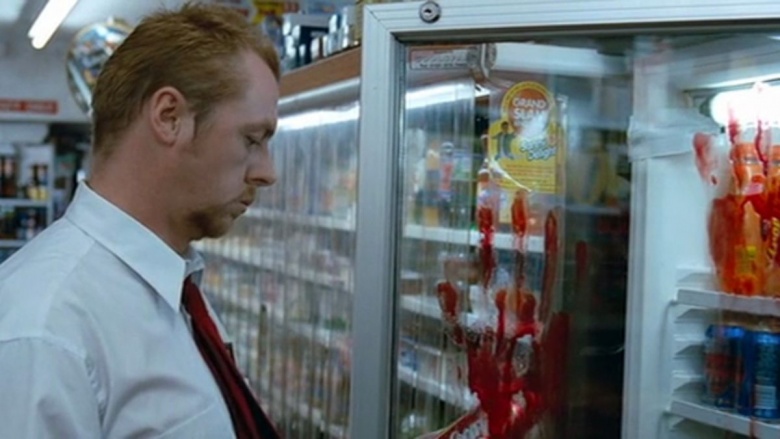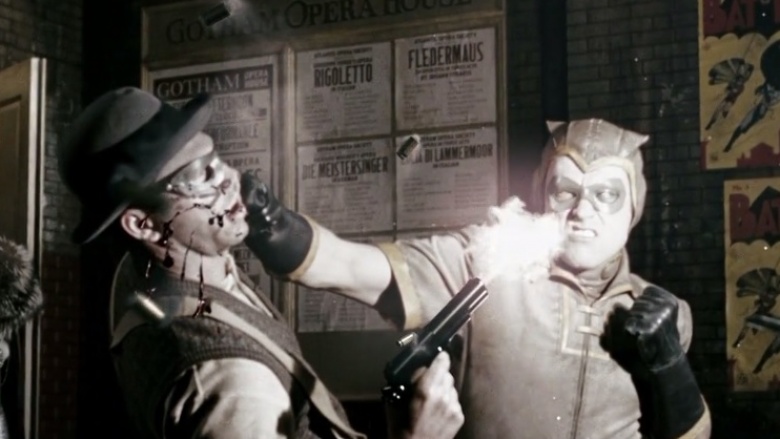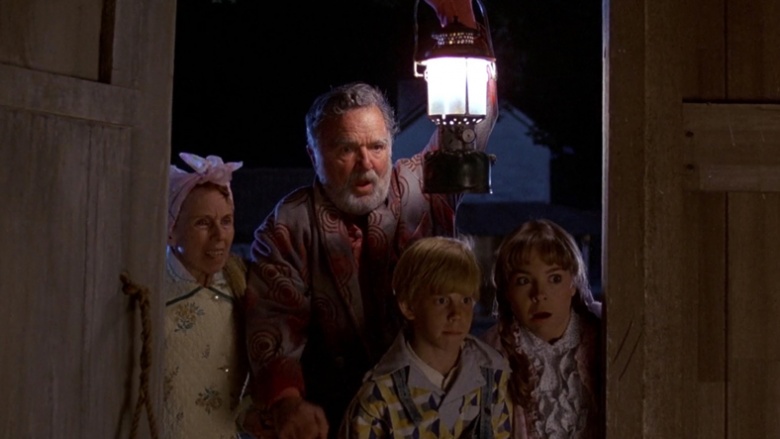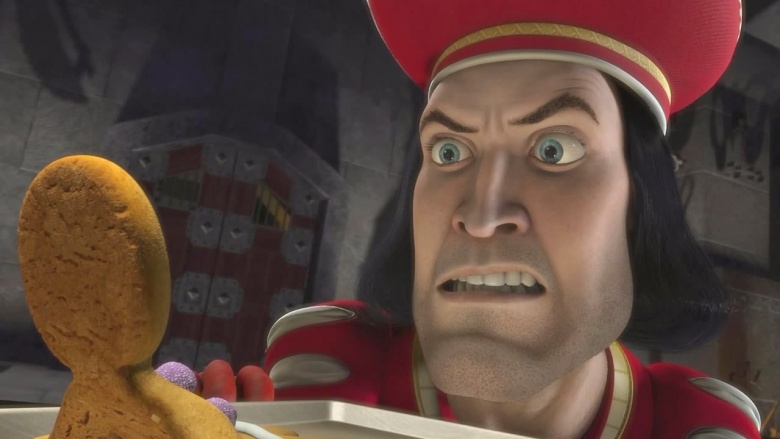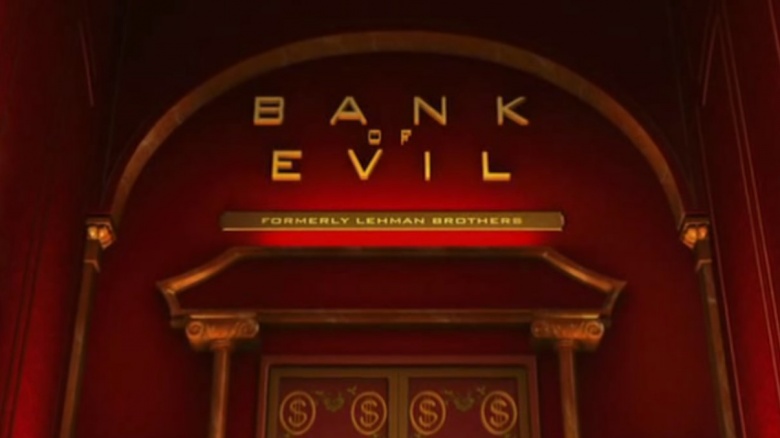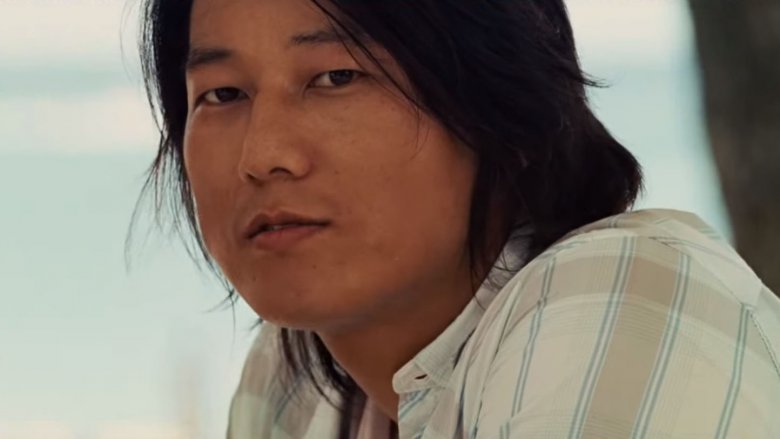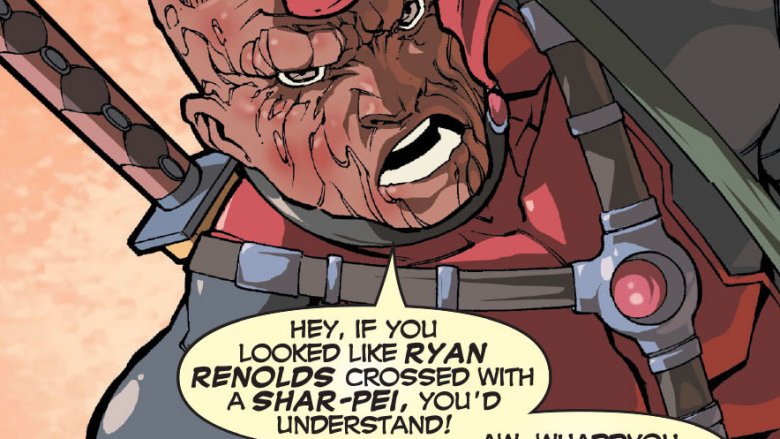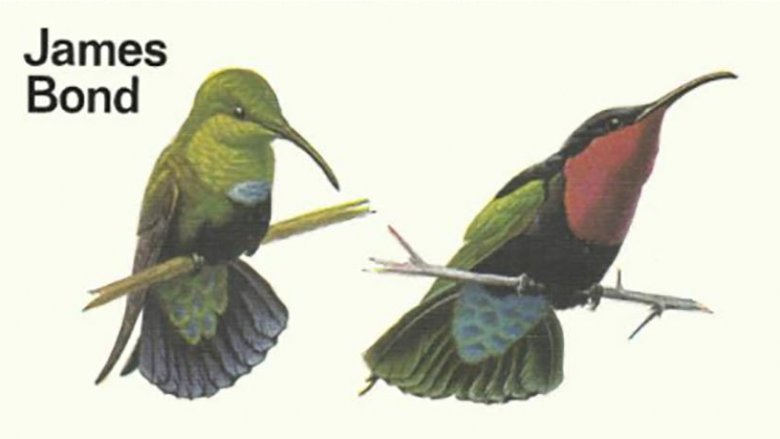The Most Obscure Movie Jokes You Probably Missed
We may receive a commission on purchases made from links.
The joy of watching a good movie can only be topped by watching it again to spot any Easter eggs or jokes you might have missed the first time around. Filmmakers sometimes hide jokes or gags so subtly that it takes a few viewings to spot them, if you're able to spot them at all. Here's a few that might just make you want to watch these flicks again so you can see them yourself.
Shaun of the Dead's spoilerific beginning
The zombie horror-comedy known as Shaun of the Dead opened the Cornetto Trilogy with a hilarious look at how a British slacker and his pub-loving friends handled the zombie apocalypse. The titular Shaun lives out a routine existence and kind of muddles through his day, with not much excitement going on. He's in a rocky place with his girlfriend, sure, but his life is otherwise dull. If he could speak Hindi, then he might have been clued into the impending zombie apocalypse when he went to the convenience store in the first act of the movie. On the radio by the checkout counter, there is a man broadcasting in Hindi that the dead are coming back to life and attacking people. How's that for a slice of fried gold?
'Watchmen' saves Thomas and Martha Wayne?
The opening sequence of Watchmen has a pretty awesome reference to a famous caped crusader. In a blink-and-you-missed-it moment, there is a frame that features Nite Owl punching the heck out of a masked gunman outside of an opera house. To be more specific, it's the Gotham Opera House. In the background is a rich couple, whom we can only assume are Thomas and Martha Wayne, Bruce Wayne's parents. According to io9, the opera bills read "Die Fledermaus," which is German for "The Bat." In the Watchmen universe, it seems like Batman never happened because Nite Owl kept the Waynes from being gunned down that fateful night.
Sherman and Peabody reference in 'Back to the Future'
There's a very subtle reference to other time travelers in Back to the Future, and you wouldn't be able to get the joke unless you stuck around for the credits. When Marty travels to 1955, he winds up crashing the DeLorean into the Peabody family's barn. The members of the Peabody family poke their heads into the barn, at which point the little boy claims that the Time Machine is actually a UFO, like the ones he's seen in his comics. If you watch through the credits, you see that this boy's name is Sherman, making him Sherman Peabody. This is a reference to the cartoon time travelers Sherman and his dog, Mr. Peabody. And, unlike the DeLorean crashing into the barn, that one flew right over most viewers' heads.
Lord Faarquad's name in 'Shrek' is a dirty, hidden joke for adults
Some of you might have realized the joke as soon as you heard his name, but apparently Lord Farquaad from Shrek was given that name to get a laugh out of the adults in the audience. Still don't get it? Well, say his name a whole lot and maybe try to say it in rapid succession. Yep, the writers gave the villain (who was rumored to be based on Disney chief Michael Eisner) his name to let the grown-ups know that he was a f—wad. Is your mind blown yet? Now take a moment to watch a supercut of all of the times they say "Farquaad" in the movie and then laugh your gumdrop buttons off.
'Despicable Me' takes a shot at the Lehman Brothers
While the Financial Crisis of 2008 is no laughing matter, the creators of Despicable Me thought a joke or two about it wouldn't hurt. If you have eagle eyes, you probably noticed that when Gru enters the Bank of Evil to get a loan, there's a small sign that reads "Formerly Lehman Brothers"—a jab at the global financial services firm that went bankrupt and filed for Chapter 11 in 2008. That event is said to have contributed to the global financial crisis, so why not stick them in a movie about supervillains?
Kevin Smith's Jaws References
Director Kevin Smith is a huge film buff, and he likes to show it. Want proof? He sneaks a boatload of Jaws references into his films. Like the Clerks salsa shark. And Mallrats features characters named Brodie Bruce and T.S. Quint, while Chasing Amy has Hooper X. Smith even takes it a step further in Chasing Amy with an homage to the scene where Jaws' characters compare scars. The twist? Instead of showing battle wounds, Banky and Alyssa compare scars they received while romancing the ladies.
Han Lue's "real" name
You probably remember Han Lue, the Korean street racer who debuts (and dies) in The Fast and the Furious: Tokyo Drift, and then returns for Fast & Furious, Fast Five, and Fast & Furious 6 thanks to shifting timeline shenanigans. You may not realize, however, that his name is a multi-layered joke that keeps paying off for fans who happen to be in the know — or who pay very, very close attention to some on-screen text.
See, before actor Sung Kang starred in Tokyo Drift, which was directed by Justin Lin, he appeared in a crime drama called Better Luck Tomorrow, which was also directed by Justin Lin. In Better Luck Tomorrow, Kang's character is named Han Hu. That's not an accident. When he took over the Fast & Furious franchise, Lin wanted to continue Han's story, so he created a different (but awfully similar) Han for Kang to play. Han Lue even has some of Han Hu's mannerisms — Han Lue constantly munches on snacks, for example, because Han Hu was a chainsmoker, and Han Lue recently quit.
Complicating things, Han Lue may not even be Fast & Furious Han's real name. In Fast Five, Han's full name (which, admittedly, could be an alias) shows up onscreen a handful of times, and appears to be Han Seoul-Oh. That's not just a tacky Korea joke (Seoul is the capital of South Korea). Say the name quickly, and you'll realize that Han's name sounds a lot like one that belongs to a different cinematic Han. You know, the other charming rogue who likes to go really, really fast and break the law, and who happens to live in a galaxy far, far away.
Drew Barrymore phones (and heads) home
Drew Barrymore didn't just star in Charlie's Angels. She's also responsible for getting the movie made. As the story goes, Barrymore and her close friend (and business partner) Nancy Juvonen spliced together a hype reel from over 200 different VHS tapes to pitch Sony on their vision for Charlie's Angels. It worked, and both women came on board as producers.
As a result, there's a lot of Barrymore in Charlie's. Tom Green, Barrymore's real-life fiancé at the time, appeared in the movie as Barrymore's character's boyfriend. The film also contains a remarkably sly reference to Barrymore's award-winning turn as five-year-old Gertie in E. T. The Extraterrestrial. In Charlie's Angels, Barrymore's character, Dylan, falls out of a window wearing nothing more than a towel. She uses the towel to break her fall, and ends up landing naked in a suburban swimming pool, while two confused (but delighted) teenage boys play video games inside.
On its own, that's not a bad gag, but look closer and you'll discover that the kids' living room has an E. T. poster on the wall. They're munching on Reese's Pieces, E. T.'s favorite snack. Best of all, however, director McG shot the scene in the exact same house where Steven Spielberg filmed E. T. almost two decades earlier. It even looks more or less the same. Little Gertie's grown up quite a bit in the intervening 18 years, but Charlie's Angels just goes to show that you really can go home again — it just takes a little while.
Nobody can get Peter Quill's superhero identity right
In one corner of the Marvel Cinematic Universe you've got the big names like Captain America, the Hulk, and Thor. In another lurk more obscure characters, like M'Baku, the Man-Ape, Skurge, and pretty much every member of the Guardians of the Galaxy.
That's not a knock on the Guardians, of course. As anyone who's seen their movies knows, they're great. And yet, before James Gunn, Chris Pratt, and the rest of the film's talented cast and crew elevated Guardians of the Galaxy to one of Marvel's most beloved franchises, most of the moviegoing public wasn't familiar with many of characters — or many of the actors, for that matter. That's not just true in the real world. It applies in-universe, too. One of the running gags in the first Guardians of the Galaxy is that almost nobody knows who the "legendary outlaw" Peter Quill is, and they've certainly never heard of "Star-Lord," Quill's preferred codename.
When Nova Corps officer Rhomann Dey (John C. Reilly) arrests Quill on Xandar, for example, he calls Quill "Space Prince." That's not the last indignity that Star-Lord suffers at the Nova Corps' hands. It's a blink-and-you'll-miss-it moment, but when Quill goes through processing after his arrest, the Nova Corps' computer system identifies him as "Space-Lord" (notably, the first Guardians of the Galaxy teaser trailer, which contains an alternate version of the scene, lists Star-Lord's name correctly, probably to avoid confusing the audience).
Life's a game to Thor: Ragnarok's Korg
Korg, the big rocky freedom fighter who helps Thor escape Sakaar in Thor: Ragnarok, steals pretty much every scene he's in, and that's not just because of director Taika Waititi's wonderfully understated line delivery. Throughout Ragnarok, Korg gets many of the movie's biggest laughs and best punchlines. He's also the source of Thor: Ragnarok's most subtle jokes, although you have to pay very close attention to notice it.
Near the beginning of the movie, Korg introduces himself to Thor with a labored Rock, Paper, Scissors joke. Little does Thor — or the audience — realize that in that moment Korg is foreshadowing later plot beats in the movie. After the film's climactic battle, Korg thinks he's killed his friend, Meek, an insect-like creature who has blades for hands. Meek ends up being fine, but if he had died, that'd be the natural order of things. See, rock beats scissors.
Unfortunately for Korg, it doesn't end there. Earlier, Korg tells Thor that his revolution failed because he didn't print enough pamphlets. He should've seen that coming. In Rock, Paper, Scissors, paper beats rock every single time.
Don't pirate RoboCop. Just don't.
A movie's end credits is a great place to stuff a few hidden gags, especially in the days before post-credits sequences became all the rage, when only a handful of people sat through the entire thing. Hot Shots!, for example, includes a recipe for "Hot Nobby Buns" right after acknowledging the movie's choreography team. Similarly, Airplane credits Adolph Hitler as the film's "Worst Boy," which seems like a fair title for a genocidal dictator.
You wouldn't expect RoboCop, Paul Verhoeven's bloody sci-fi action movie, to get in on the fun — RoboCop is satirical, but it's not exactly a comedy — and yet there it is, right at the very end of the film: an actual, honest-to-goodness joke. The boilerplate text warning potential bootleggers against "unauthorized duplication, distribution or exhibition of the film" ends with a particularly dire warning. Anyone found violating RoboCop's copyright is a candidate for "civil liability and criminal prosecution by enforcement droids."
If you've seen RoboCop, which opens with an ED-209 enforcement droid malfunctioning and killing an executive, and later pits the machine against RoboCop in a series of brutal battles, that should be enough to scare you away for good. On one hand, RoboCop's post-credit warning feels strange and out of place. On the other, the whole movie takes place in a corporately-ruled dystopia. In RoboCop's world, the idea that a movie studio might use deadly force to prosecute pirates isn't all that far-fetched.
The most dangerous brain in the world
More or less all of Gremlins 2: The New Batch is some kind of reference, parody, or callback. While the first movie is a (mostly) straightforward horror-comedy, the unhinged sequel is more like a live action Looney Tunes flick. There are jokes and throwbacks to classic films (including the first movie) everywhere, and documenting all of Gremlins 2's affectionate spoofs could fill an entire book.
So we're just going to focus on one, which is arguably the most esoteric reference in the entire 106-minute film. Among the many oddities scattered around the Splice O' Life genetics laboratory, including the various serums that give Gremlins 2's mischievous stars their superpowers, is a brain in a jar. The jar has a label that reads "W. H. Donovan," presumably naming the brain's original owner.
That's not just a piece of set dressing. It's an in-joke for old horror movie buffs. In 1953, director Felix E. Feist and United Artists released Donovan's Brain, based on Curt Siodmak's novel of the same name. In the movie, which stars Nancy Davis (better known as Nancy Reagan, the former First Lady of the United States of America), a businessman named W. H. Donovan dies in a plane crash, but a scientist manages to keep his brain alive in a jar full of solution. Donovan uses telepathy to take over the scientist's body and causes havoc until lightning strikes the doctor's house, setting the brain on fire and ending its reign of terror.
Getting busy at Hogwarts
The Harry Potter movies are largely family-friendly affairs, as befits a series of films based on young adult novels and starring children. However, that didn't stop someone from sneaking a very G-rated sex scene into the third movie, Harry Potter and the Prisoner of Azkaban. See, Prisoner of Azkaban's end credits play over a live rendering of the Marauder's Map, a magical artifact that tracks the location of every single Hogwarts resident.
The map doesn't actually show people. It uses footprints and text to represent Hogwarts' students, faculty, and staff, which is how Prisoner of Azkaban's end-credit designers were able to sneak in the only on-camera sex scene in Harry Potter history. At one point, a pair of footprints appear in a secluded room on the lower left corner of the screen. Look at their position. One of the people has their legs—and therefore, their feet—spread apart, angling outwards. The other occupant is standing between the wide-open legs, facing in the opposite direction.
There's really only one logical explanation for such weird position: someone at Hogwarts is getting lucky. Unfortunately, the map doesn't reveal the thirsty wizards' names, so their identities are still unknown. Thankfully, that's exactly the kind of mystery that fan fiction can solve. Get on it, writers. We're waiting for answers.
Deadpool's other origin story
Ryan Reynolds is a good-looking guy. Deadpool, his most famous character, isn't. The experimental treatment that saved Deadpool from cancer and gave him his his healing powers also left him indescribably ugly — but, true to form, Wade Wilson's business associate Weasel tries to describe him anyway. That leads to one of the funniest scenes in the film, and while most of Weasel's metaphors are too vulgar to repeat here (a poet the guy ain't), Weasel's argument that Deadpool looks like he's been bitten by a "a radioactive Shar-Pei" is both funny and clean. That's a winning combination.
It's also an elaborate in-joke for both Reynolds and diehard Deadpool fans. In an early '00s Deadpool comic, Wade describes himself as looking like a cross between Ryan Reynolds — yes, that Ryan Reynolds — and a Shar-Pei. It's a pivotal moment in Deadpool history. See, while filming Blade: Trinity, a studio executive told Reynolds that he'd make a great onscreen Deadpool and sent the actor a stack of comics to read. The very first comic Reynolds picked up (Cable and Deadpool #2, apparently) had the fateful panel in it. That was all the convincing that Reynolds needed, and he's been a fan of the character ever since — even if the comic in question did misspell the actor's name.
Mark Hamill makes a funny just by showing up
In Kingsman: The Secret Service, Mark Hamill plays James Arnold, a professor whose kidnapping kicks off Kingsman's twisty and hysterically ultra-violent spy adventure. Hamill's appearance isn't much more than a cameo — shortly after a botched rescue attempt leads to the murder of a top-ranking Kingsman officer, Hamill's character is killed when a chip in his neck explodes — but it doesn't matter. Simply having Hamill appear onscreen is a deep cut in and of itself.
In The Secret Service, the Mark Millar and Dave Gibbons comic book that Kingsman is based on, the kidnap victim isn't James Arnold. It's Mark Hamill — like, actual Mark Hamill, the Star Wars actor. In the comic, Hamill's kidnappers yell at him about the Star Wars prequel trilogy (which Hamill wasn't in), and he dies in a brutal, bloody, and thoroughly disrespectful fashion during the Kingsman's rescue attempt. Hamill isn't playing the same character (i.e. himself) in the film, but his casting is an obvious nod to comic book readers, as well as a good indication of Hamill's sense of humor.
Hamill signed off on his original pencil-and-ink cameo, too. Before The Secret Service went to print, Millar called Hamill to ask for permission to kill him off, and the two became friends. Millar asked if Hamill would be willing to appear in a movie adaptation, and thus, one of the slyest in-jokes in modern cinema was born.
James Bond reads James Bond
Die Another Day is one of the more divisive Bond flicks — even former 007 Roger Moore thinks it stretches credulity a little too far — but it does honor Bond's past. As an unofficial celebration of James Bond's 40th big-screen anniversary, Die Another Day is full of references and in-jokes for James' biggest fans. Jinx, played by Halle Berry, first appears onscreen on a scene that echoes Honey Ryder's swimsuit-clad debut in Dr. No. Thunderball's jetpack returns, as does The Spy Who Loved Me's Union Jack parachute. The phrase "diamonds are forever" pops up a few times, and vehicles from Octopussy can be seen safely tucked away in Q's lab.
But Bond isn't just a movie star. He first appeared in a series of novels written by former British intelligence officer Ian Fleming. Die Another Day pays tribute to him, too. While undercover in Havana, Pierce Brosnan's Bond picks up a book called Birds of the West Indies. That's awfully dry reading, especially for a super-spy, but the book has a special place in 007's history — it gave James Bond got his name.
Specifically, Fleming wanted a name that was masculine but as "ordinary as possible." Bond is a spy, after all, and a flashy name would just call attention to itself. Fleming, an avid bird-watcher, had a copy of Birds of the West Indies on his shelf, and when he noticed the author's name — James Bond, of course — he took it and made it famous. That's not the only layer to the joke, either. As everyone knows, Bond is quite fond of birds himself — "bird" being British slang for a young woman, of course.
